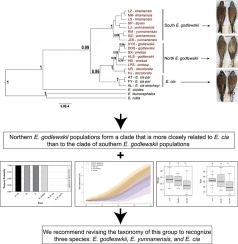Jim LeNomenclatoriste
Je suis un mignon petit Traquet rubicole

October 2021
October 25
Emberizidae — Old World Buntings: I'm now using the phylogeny of Päckert et al. (2020b), rather than Päckert et al. (2015). As a result, I've divided Emberizidae into 4 subfamilies. Of them, only Emberizinae has a name under ICZN rules. I'm using the informal terms Melophinae, Fringillariinae, and Schoeniclinae for the other three. These subfamilies have the same composition as the same clades previously had. However, their order has changed.
[Emberizidae, Core Passeroidea, 3.06]
New Emberizid genera: With genera becoming subfamilies, more genera are in order. The generic divisions are based on three principles. They must be (1) based on the phylogeny, (2) roughly 5-10 million years old, and (3) form groups that are as coherent as possible. This involved adding 11 genera. Two lack names, and have been given temporary designations in quotes. Here are the new genera:
"Melophus": Brown-rumped Bunting, Melophus affinis, is transferred from Melophus to "Melophus".
Granativora: Black-headed Bunting, Melophus melanocephalus, and Red-headed Bunting, Melophus bruniceps, are transferred from Melophus to Granativora (GR Gray, 1855, type melanocephalus).
Miliaria: Corn Bunting, Emberiza calandra, is transferred from Emberiza to Miliaria (Brehm 1828, monotypic).
Spina: Chestnut-eared Bunting, Emberiza fucata, is transferred from Emberiza to Spina (Kaup 1829, monotypic).
"Emberiza": Tibetan Bunting, Emberiza koslowi, is transferred from Emberiza to "Emberiza".
Cia: Jankowski's Bunting, Emberiza jankowskii, through Godlewski's Bunting, Emberiza godlewskii, are transferred from Emberiza to Cia (Kaup 1829, type cia).
Glycyspina: Gray-necked Bunting, Emberiza buchanani, through Cretzschmar's Bunting, Emberiza caesia, are transferred from Emberiza to Glycyspina (Cabanis 1851, type hortulana).
Polymitra: Cabanis's Bunting, Fringillaria cabanisi, Golden-breasted Bunting, Fringillaria flaviventris, and Somali Bunting Fringillaria poliopleura, are transferred from Fringillaria to Polymitra (Cabanis 1851, type flaviventris).
Cristemberiza: Yellow-throated Bunting, Schoeniclus elegans, is transferred to Cristemberiza (Momiyama 1928, monotypic).
Latoucheornis: Slaty Bunting, Schoeniclus siemsseni, is transferred to Latoucheornis (Bangs 1931, monotypic).
Orospina: Rustic Bunting, Schoeniclus rustica, through Gray Bunting, Schoeniclus variabilis, are transferred to Orospina (Kaup 1829, type rustica).
[Emberizidae, Core Passeroidea, 3.06]
Sharpe's Bunting: I added the second English name Yunnan Bunting (HBW Illustrated Checklist) to Sharpe's Bunting, Cia yunnanensis.
[Emberizidae, Core Passeroidea, 3.06]










